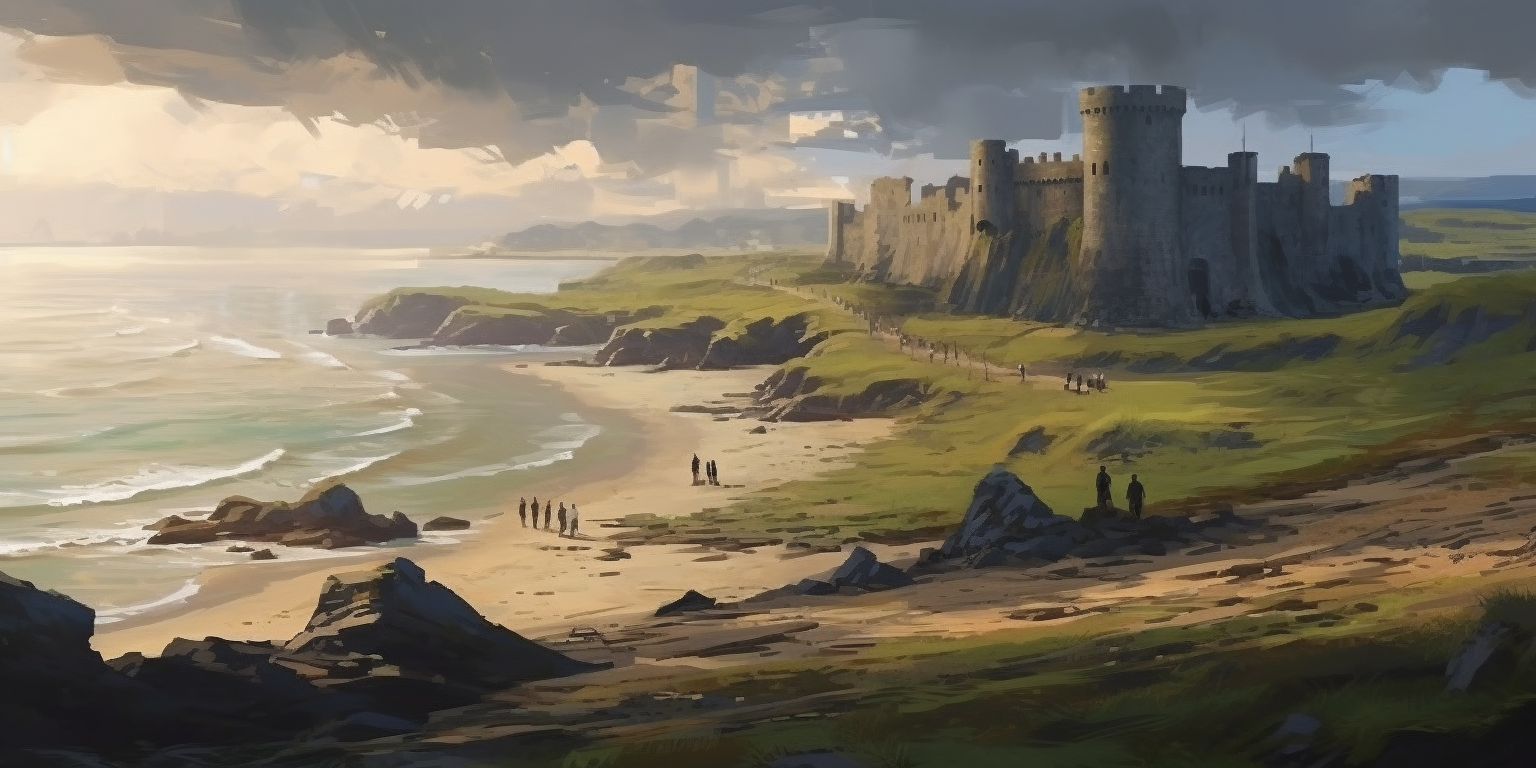Fort Rakiman: Saint's Maar Embassy
Fort Rakiman was built by the human and Tara-Jhen inhabitants of Kazbur before the Eruption of Taktaalak in the year 886 EG. Following the near destruction of Tazban (which served as a capital for the extinct nation), the small villages and towns along the continent would fall to the hardships of Ettermiddag with nowhere to go. Rakiman would serve as one of the last centers of civilization in the region, but it was left abandoned by the end of the century. It wasn't until the Kaban were liberated that its halls were filled once more. At the time, the influx of new citizens desired Rakiman to be a beacon of their freedom, but the land would eventually be deemed incapable of sustaining a growing population. The fort would serve as an important cultural center for the Kaban until its occupation by the Augury forty-five years after its reclamation.
Under the Augury, the fort would serve as an embassy. Politicians, merchants, and the occasional tourist use the embassy to this day (ca. 1947 NG), and are always attempting to improve relations with the Kaban. The travelers typically come from Saint's Maar and keep track of the Kaban population, standards of living, supply lines, and disposition toward foreigners. On rare occasions, it has been the site of military activity when the Tara-Jhen get anxious for more land, though these incidents have fallen in the last century.
Shortly after The Silence, the Kaban would congregate behind the crumbling walls of an unnamed and abandoned fort, which they would call "Rakiman." Several of its quarters were still intact, such as a banquet room, slaves quarters, barracks, and 9 bedrooms. Over time, the Kaban would patch the loose walls with sandstone and clay.
Unlike the Augury, the Kaban paid little mind to the residents that built the fort. Statues were toppled, "unnecessary" dividing walls were removed, and several foreign icons were cast to the waves. By the end of the renovations, the courtyards were filled with huts and the majority of daily activities took place in the courtyard or beyond the walls.
In the year 1810 NG the Orator over Rakiman would find an icon, now known as the Iowata, buried within a mass grave south of the fort. The small statue displayed a single head that shared two faces: one of a human on the front and the other of a lizard on the back. Claiming that it communed similarly to Korahaman, he took it as an opportunity to seek true divinity. He would step away from his position as Orator and travel to the ancient city of Tazban with a small group of monks. His exit resulted in social unrest and the egress of several families. In the years following, more icons of the Iowata were discovered and several rumors began spreading about their placement and potential curses surrounding them.
Kaban fundamentalists were willing to embrace the implications of the Iowata as a new patron and god incarnate, but none had lived to serve such an entity themselves. Most were apprehensive about outside patrons due to the recent Quai activity during The Silence, and by the year 1825, most fundamentalists were ousted from the walls. Rakiman was eventually considered a complete cultural failure, and its ownership was passed off to the Augury through slow political assimilation.
The Augury took control of Fort Rakiman in the year 1827 NG. Rakiman originally served as a center for trade and diplomatic discussion between the two peoples; none of its denizens suspected that the Augury had its eyes on assimilating the fort. One year after humans were allowed within its walls, the Augury coerced the cities of Mot D'nir to recognize the tortoisefolk freedom, banning any future enslavement (and gaining positive relations with Rakiman).
After the first year, Saint's Maar haggled for the presence of a research team to investigate the region. The majority of their work was related to the excavation of "refuse" the Kaban had thrown to the tides. Among them were icons of forgotten gods, waterlogged urns, strange furniture, and mummified pets. While they were housed within Rakiman, the researchers recreated floorplans, took part in drunken manipulation of the Orator, and developed pricey snake oils to take advantage of recent curse superstitions. Over time, the Orator was convinced that the fort was a lost cause and would sell the land for 10,000 gold, guaranteed construction of Augury-Kazbur ports, and protection from pirates in Eastern Kazbur.
The Augury would rebuild what the Kaban had destroyed, line the walls with ballistae, and move several politicians and military men of Saint's Maar into the new facilities. Kaban would still walk the halls, but most were hoping for vertical movement within the Augury rather than wishing to stay close to home (making them black sheep of Kaban society at the time).
Rakiman is still an Augury territory to this day (ca. 1947 NG). Relations between the two people have never been better, largely due to the Kaban finding better success away from Rakiman. The fort has grown three times its initial size (thanks to funding from the Osman family) and became the jumping-off point for three smaller embassies across Kazbur.
The surrounding area includes small villages, all of which are buried beneath the sand. The buildings discovered included a buried hatchery, three small houses, and an orchard. Presumably, Rakiman was originally a castle to a greater city or lordship that provided much-needed protection to the surrounding citizens.
Presently, Rakiman serves as an embassy for ambassadors from Saint's Maar to safely reside while performing duties in either Mot D'nir or Kazbur. The most common transactions occurring within the fort are trade discussions, census collection, immigration, and occasional permissions for Augury research.
Related Location: Eastern Kazbur
Entry: Allowed (permission/proof of citizenship required)
Food: Provided
Ports: 1 (Property of the Augury)
Roads: none
Under the Kaban
Unlike the Augury, the Kaban paid little mind to the residents that built the fort. Statues were toppled, "unnecessary" dividing walls were removed, and several foreign icons were cast to the waves. By the end of the renovations, the courtyards were filled with huts and the majority of daily activities took place in the courtyard or beyond the walls.
In the year 1810 NG the Orator over Rakiman would find an icon, now known as the Iowata, buried within a mass grave south of the fort. The small statue displayed a single head that shared two faces: one of a human on the front and the other of a lizard on the back. Claiming that it communed similarly to Korahaman, he took it as an opportunity to seek true divinity. He would step away from his position as Orator and travel to the ancient city of Tazban with a small group of monks. His exit resulted in social unrest and the egress of several families. In the years following, more icons of the Iowata were discovered and several rumors began spreading about their placement and potential curses surrounding them.
Kaban fundamentalists were willing to embrace the implications of the Iowata as a new patron and god incarnate, but none had lived to serve such an entity themselves. Most were apprehensive about outside patrons due to the recent Quai activity during The Silence, and by the year 1825, most fundamentalists were ousted from the walls. Rakiman was eventually considered a complete cultural failure, and its ownership was passed off to the Augury through slow political assimilation.
Under the Augury
After the first year, Saint's Maar haggled for the presence of a research team to investigate the region. The majority of their work was related to the excavation of "refuse" the Kaban had thrown to the tides. Among them were icons of forgotten gods, waterlogged urns, strange furniture, and mummified pets. While they were housed within Rakiman, the researchers recreated floorplans, took part in drunken manipulation of the Orator, and developed pricey snake oils to take advantage of recent curse superstitions. Over time, the Orator was convinced that the fort was a lost cause and would sell the land for 10,000 gold, guaranteed construction of Augury-Kazbur ports, and protection from pirates in Eastern Kazbur.
The Augury would rebuild what the Kaban had destroyed, line the walls with ballistae, and move several politicians and military men of Saint's Maar into the new facilities. Kaban would still walk the halls, but most were hoping for vertical movement within the Augury rather than wishing to stay close to home (making them black sheep of Kaban society at the time).
Rakiman is still an Augury territory to this day (ca. 1947 NG). Relations between the two people have never been better, largely due to the Kaban finding better success away from Rakiman. The fort has grown three times its initial size (thanks to funding from the Osman family) and became the jumping-off point for three smaller embassies across Kazbur.
Design and Purpose
The fort has the design of a concentric castle, with two layers of walls, a courtyard in the center, and a keep in the back (directly across from the entrance). The design implies a dire need for ranged defense, though few threats in the area would merit such reinforcement. Researchers believe that the humans and Tara-Jhen that constructed it faced regular invasions from surrounding civilizations which are now lost to time.The surrounding area includes small villages, all of which are buried beneath the sand. The buildings discovered included a buried hatchery, three small houses, and an orchard. Presumably, Rakiman was originally a castle to a greater city or lordship that provided much-needed protection to the surrounding citizens.
Presently, Rakiman serves as an embassy for ambassadors from Saint's Maar to safely reside while performing duties in either Mot D'nir or Kazbur. The most common transactions occurring within the fort are trade discussions, census collection, immigration, and occasional permissions for Augury research.
Travelers Guide
Occupying Government: Augury, Saint's MaarRelated Location: Eastern Kazbur
Entry: Allowed (permission/proof of citizenship required)
Food: Provided
Ports: 1 (Property of the Augury)
Roads: none
"The Kaban are known to concern themselves with the worldly. Their activities, their culture, and even the gods they worshipped were of this world. By that metric, they should consider themselves lucky after the Silence. All of their gods are still here! Unfortuantely, beyond my good jests, I don't bear good news regarding Rakiman. The tortoisefolk have long worshipped the troublesome, with Kadelkonatl the chief among them, until now. Let the little people have their festivals for false gods of mischief, but now they stand at our doors wishing for more icons that we have stowed away to the Maar. The Orator that left in years prior has dug his way into our occupation of Tazban, and I fear the scholars lacking in common sense in the face of "good will." At this rate, half of the Tazban population will be Kaban! I am sending orders for our men to confiscate any icons to this "Iowata" until further notice. Osman has already offered 1000 gold pieces for artifacts such as these, and the Maar has little need for more. We find more and more with each day of digging in the old city, and I think it safe to say that none of the Kaban gods have ever spelled anything positive for humanity. Shy of the Augurs themselves interfering, this shall be my perogative going forward."The Iowata




The castle art reminds me of Bamburgh Castle, Northumberland UK.